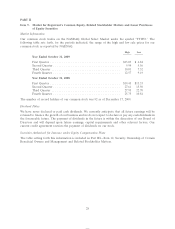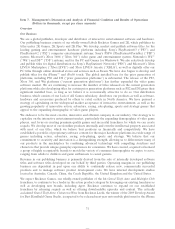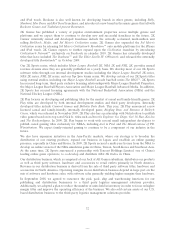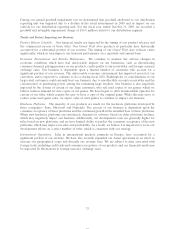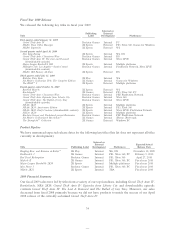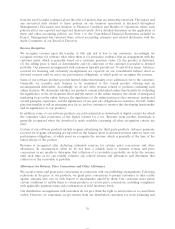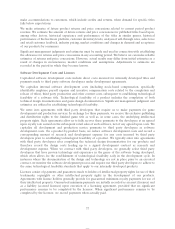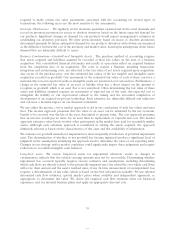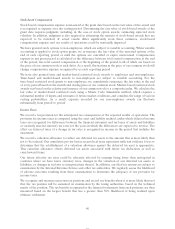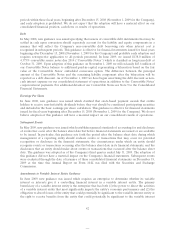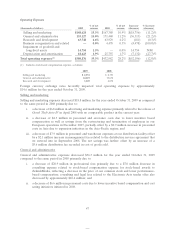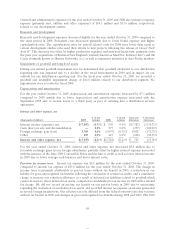2K Sports 2009 Annual Report Download - page 43
Download and view the complete annual report
Please find page 43 of the 2009 2K Sports annual report below. You can navigate through the pages in the report by either clicking on the pages listed below, or by using the keyword search tool below to find specific information within the annual report.Certain licenses, especially those related to our sports products, extend over multi-year periods and
encompass multiple game titles. In addition to guaranteed minimum payments, these licenses frequently
contain provisions that could require us to pay royalties to the license holder based on pre-agreed unit
sales thresholds.
Amortization of capitalized software development costs and licenses commences when a product is
released and is recorded on a title-by-title basis in cost of goods sold. For capitalized software development
costs, amortization is calculated using (1) the proportion of current year revenues to the total revenues
expected to be recorded over the life of the title or (2) the straight-line method over the remaining
estimated useful life of the title, whichever is greater. For capitalized licenses, amortization is calculated as
a ratio of (1) current period revenues to the total revenues expected to be recorded over the remaining life
of the title or (2) the contractual royalty rate based on actual net product sales as defined in the licensing
agreement, whichever is greater.
Significant management judgments and estimates are utilized in the assessment of the recoverability of
capitalized software costs. At each balance sheet date, or earlier if an indicator of impairment exists, we
evaluate the recoverability of capitalized software costs, licenses and any other unrecognized minimum
commitments that have not been paid, using an undiscounted future cash flow analysis. We use various
measures to evaluate expected product performance and estimate future revenues for our software titles
including historical performance of comparable titles; orders for titles prior to release; and the estimated
performance of a sequel title based on the performance of the title on which the sequel is based. When
management determines that the value of a title is unlikely to be recovered by product sales, capitalized
costs are charged to cost of goods sold in the period in which such determination is made.
We have established profit and unit sales based internal royalty programs that provide for certain of our
employees to participate in the success of software titles that they assist in developing. Royalties earned by
employees under this program are recorded as cost of goods sold as they are incurred.
Fair Value Estimates
The preparation of financial statements in conformity with GAAP often requires us to determine the fair
value of a particular item to fairly present our Consolidated Financial Statements. Without an independent
market or another representative transaction, determining the fair value of a particular item requires us to
make several assumptions that are inherently difficult to predict and can have a material impact on the
conclusion of the appropriate accounting.
There are various valuation techniques used to estimate fair value. These include (1) the market approach
where market transactions for identical or comparable assets or liabilities are used to determine the fair
value, (2) the income approach, which uses valuation techniques to convert future amounts (for example,
future cash flows or future earnings) to a single present amount, and (3) the cost approach, which is based
on the amount that would be required to replace an asset. For many of our fair value estimates, including
our estimates of the fair value of acquired intangible assets, we use the income approach. Using the income
approach requires the use of financial models, which require us to make various estimates including, but
not limited to (1) the potential future cash flows for the asset, liability or equity instrument being
measured, (2) the timing of receipt or payment of those future cash flows, (3) the time value of money
associated with the delayed receipt or payment of such cash flows, and (4) the inherent risk associated with
the cash flows (risk premium). Making these cash flow estimates are inherently difficult and subjective,
and, if any of the estimates used to determine the fair value using the income approach turns out to be
inaccurate, our financial results may be negatively impacted. Furthermore, relatively small changes in many
of these estimates can have a significant impact on the estimated fair value resulting from the financial
models or the related accounting conclusion reached. For example, a relatively small change in the
estimated fair value of an asset may change a conclusion as to whether an asset is impaired. While we are
38


